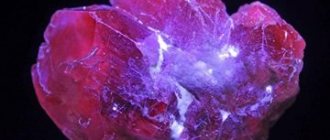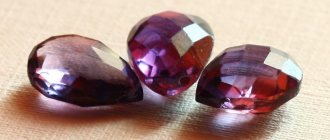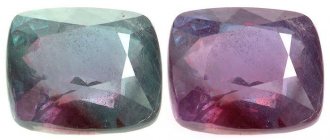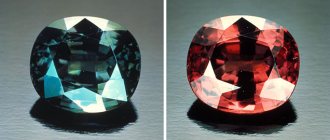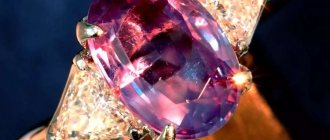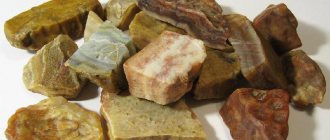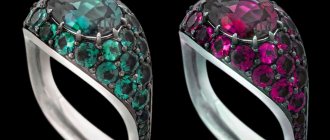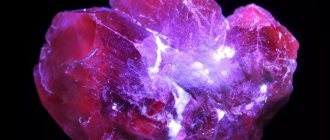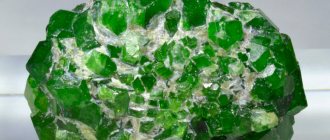In nature, there are many precious stones, as well as amazing minerals, amazing in their diversity. Moreover, real stones do not require any special cutting or excessive advertising. Each stone, precious or semi-precious, has its own history and holds the memory of other generations.
Alexandrite stone is the most unique and expensive variety of the mineral called chrysoberyl. Its meaning has a direct connection with a specific period of history. This stone is endowed by nature with amazing magical qualities. In addition, its color changes and depends on the light intensity. Unfortunately, this gemstone is rarely found, which is why it is among the top five most unusual and rare minerals.
History and origin
Alexandrite is rightfully considered a native Russian stone. The world's first specimen of the mineral was found in emerald mines near Yekaterinburg. This happened not so long ago, in the 30s of the 19th century, but now there are two versions of this event, which voice different dates of the discovery and different names of the discoverers.
According to one interpretation, the nugget was first found by Nils Nordenskiöld on April 17, 1834. The Finnish scientist did not have the opportunity to meticulously examine the strange find in the field, so at the first examination, the mineralogist decided that he had discovered an emerald crystal of not the highest degree of purity. This conclusion was based on the fact that the sample had a rich green color and low refractive indices.
After measuring the hardness of the stone, the confidence that it was an emerald was shaken. The instruments showed a value of 8.5 points on the Mohs scale, while for emerald this indicator should be a point lower. That same day, late in the evening, the scientist decided to examine the find by candlelight. Imagine Nordenskiöld's amazement when, instead of a green gem, he took a fiery red stone out of his pocket. The discovery of alexandrite occurred on the 16th birthday of Alexander II, the future Emperor of Russia, so the mineral was named in his honor.
Another version differs significantly from the first. Thus, alexandrite was discovered a year earlier, in 1833. The discovery was made by Ya. V. Kokovin. This happened in the emerald mines of the Tokovaya River, so the mineral was initially described as an emerald. The find was sent to St. Petersburg for detailed study.
There, Minister of Development L.A. Perovsky, assessing the increased hardness and pronounced pleochroism (change of color), concluded that it was not an emerald. At first they decided to call the find diaphanite, but later an opportunity arose to distinguish itself at court. Therefore, Perovsky presented the gem to the 16th anniversary of Alexander II, naming the stone after the future emperor.
This is interesting! In 1840, an alexandrite druse consisting of 22 crystals was discovered. The unique Ural find weighs almost 5.5 kg and is located in the Fersman Museum.
The Russian Empire, by chance, gave alexandrite many nicknames. First of all, the mineral became famous under the name “imperial stone”, as it became the personal amulet of Emperor Alexander II. It is known that during his life the Russian Tsar was able to escape the death prepared for him by his ill-wishers seven times. Only the eighth attempt became fatal for him. There is an opinion that Alexander’s life was preserved for many years by a ring with alexandrite. In addition, the nugget was green in daylight and red in evening light, which symbolized the two national colors of Russia.
Do you know that not only alexandrite can change its shade depending on the lighting. Green in daylight, and red in lamplight, can be a variety of garnet with chromium impurities, as well as polychroid green sapphire.
Almost immediately after the discovery of the gem, it became very popular among the Russian nobility. Moreover, people of exclusively noble origin who bore noble names could have alexandrite jewelry. The mineral became a heirloom. Even the richest merchants could not possess the desired jewel, since they had finances, but did not have a noble surname.
Thus, entering the 20th century, alexandrite became a fabulously expensive gem. By that time, all Russian nobility already possessed a sufficient amount of status jewelry. The outbreak of the First World War brought another glory to the mineral and another name – “widow’s stone”. The fact is that all Russian officers were of noble birth and the war took them all away in the first half of the year. Therefore, alexandrite became a symbol of women who did not receive their husbands from the battlefield.
A description of the stone in scientific literature appeared only in 1842. For a long time, the royal gem was considered an original Russian stone. Only at the end of the 20th century, other countries of the world began to find the mineral one by one - Brazil, South Africa, the islands of Sri Lanka and Madagascar.
Also read: Euclase is a rare mineral and a powerful talisman
Rules for wearing and care
The gem is stored in a box out of direct sunlight. Also, the mineral should not be exposed to high temperatures or ultraviolet radiation. This can destroy the atomic structure and affect the appearance of the stone.
It is not recommended to wear the crystal on sunny or hot days. Despite its high hardness on the Mohs scale, alexandrite cannot be subjected to mechanical stress. Repeated drops or impacts of the mineral will cause microscopic cracks, which will later appear as internal defects or scratches on the surface.
Place of Birth
Russia is famous for its largest European deposit, the only one of its kind. Alexandrite is a rare mineral. Of the thousands of tons of processed rock at the Malyshevskoye deposit in the Urals, only 100 grams of alexandrite are mined daily. For comparison, the amount of mined emeralds is 15 times greater.
The island state of Sri Lanka is also considered a valuable supplier of the mineral. Brazilians today find only rare individual specimens of the gem, since their only deposit was mined in just 3 months back in 1987.
Along with sapphires and rubies, alexandrites are mined on the island of Madagascar and Tanzania. However, the color changes of African stones are less contrasting.
Main conclusions
Stone of loneliness, imperial, widow's, chameleon - alexandrite has many names, one way or another reflecting its unusual properties. At the same time, it is also considered a symbol of good luck, a talisman that brings wealth and prosperity. It cannot be given to single women or just one person in a couple, but it will become an excellent amulet for strong-willed people who are prone to travel, risk and adventure.
- This type of chrysoberyl is mined in Brazil, Tanzania, Madagascar and Sri Lanka. Russian and Ceylon gems are still considered the best in the world.
- The stone is credited with many healing properties, primarily associated with diseases of the blood, blood vessels and heart.
- The mystical qualities of alexandrite include its ability to change color under different types of lighting. It is believed that the stone, by changing its shade, can warn of impending trouble or misfortune.
- The mineral is suitable for water and earth signs of the zodiac.
- Natural alexandrite is a rare and expensive stone. The cost of one carat can exceed 50 thousand rubles (about 750 dollars). The color reverse and drop-shaped bubbles are evidence of the authenticity of the material.
Jewelry with alexandrite can be an excellent gift, which over time will easily become a family heirloom with its own equally interesting history and legends.
Physical properties
Alexandrite is one of the varieties of chrysoberyl. Chromium impurities, as well as the structural features of the mineral’s crystal lattice, give the stone pronounced pleochroism.
| Property | Description |
| Formula | Al2BeO4 |
| Impurity | Cr |
| Hardness | 8,5 |
| Density | 3.5–3.84 g/cm³ |
| Refractive index | 1,744–1,758 |
| singonia | Rhombic. |
| Kink | Conchoidal. |
| Cleavage | Imperfect. |
| Shine | Glass. |
| Transparency | Transparent or translucent. |
| Color | In daylight: dark blue-green, bluish green, dark grass green, olive green; In evening or artificial light: pink-crimson, red-violet, purple. |
This "Alexandrite effect" allows the gem to appear blue-green, olive green or grassy in sunlight and crimson, violet-red or purple in dim evening light. Some gem samples are endowed with opalescence - a cat's eye effect.
Description of the alexandrite stone
As already noted, alexandrite is one of the varieties of chrysoberyl and is characterized by a unique biochemical composition. In addition to iron, the stone contains vanadium, as well as chromium ions. It is these ions that cause changes in the color of the mineral under different lighting conditions. Experts call this phenomenon a special term – “color reverse”.
It is a transparent mineral with color. The most common is bluish-green. Olive and amber colors with yellowish and brown tints are somewhat less common.
The color is directly dependent on the mineral deposit. Ural alexandrites are rightfully considered the most beautiful and elegant types of stone. If it is in natural light, it turns bluish-green. Under artificial light, the stone takes on purple, reddish and crimson shades. If the mineral is brought from Africa or Brazil, it has a brown-golden color. When artificial light is shined on it, it takes on red, purple and crimson tints. Stones from the island of Sri Lanka turn purple in the evening.
In jewelry, granite pegmatites are used, which are the main source of alexandrite. It is formed by small prismatic crystals that are fused into tees into six-cornered shapes. This stone consists of plates and has stunning shiny facets. There is a barely visible shading on their surface, which strongly resembles a six-pointed star.
Colors and varieties
Alexandrite belongs to minerals without a clear classification of varieties. All stones are characterized by a change in color when lighting changes from natural to artificial. The phenomenon of pleochroism in the language of jewelers is called color reverse.
Alexandrite is the same chameleon. During the day, the stone casts all shades of green, sometimes with an admixture of blue. In the evening, the stone is rich in other colors - from pink to dark red. There are examples of evening scarlet or lilac. And under some types of lamps, alexandrite can turn yellow.
If we compare nuggets by place of extraction, then Russian gems are certainly brighter than Brazilian or African ones. But Ceylon specimens, originally from Sri Lanka, compete with Ural gems in the presence of unusual effects, for example, opalescence.
Varieties of mineral
Without knowing what this “chameleon” is, it is very easy to stumble upon a fake. Before buying products with alexandrite, understand what distinctive properties it has:
- the color of alexandrite in daylight ranges from blue to green shades;
- when in a room where lamps are turned on or candles are lit, the gem changes its color to a blood-crimson color.
This is general information to help distinguish an artificial alexandrite stone from a real one. But it is a mineral found in several varieties. Each of them has its own differences depending on the deposit.
Alexandrite changes its color depending on the lighting.
For example:
- The Ural species is recognized as the mineral with the most beautiful color palette. In artificial light it appears purple or violet.
- Brazilian. It has smoother transitions between colors compared to the bright contrasts of the Ural mineral.
- The Indian gem plays green-blue hues in daytime color.
- The color of stone mined in Sri Lanka appears duller in sunlight and has a brownish tint.
Medicinal properties
One of the French esotericists drew a parallel between two shades of alexandrite and similar colors of human blood - venous and arterial. This is how the direct effect of natural gemstone on the human circulatory system was discovered:
- improvement of blood composition;
- help with varicose veins;
- cleansing and strengthening blood vessels;
- positive effect on heart rate and blood pressure;
- prevention of blood clots.
Lithotherapists note a therapeutic effect for diseases of the liver, spleen, gastrointestinal tract, as well as in the case of nervous system disorders - depression, insomnia, apathy, and the like.
Alexandrite will be useful for people who want to get rid of alcohol addiction. Water infused with alexandrite overnight will help you get rid of your bad habit. In addition, the gem is a general preventive remedy, provided that the stone is natural.
Artificial alexandrite
Attempts to create artificial alexandrite have been ongoing since the second half of the 20th century. Some experiments turned out to be successful:
- Czochralski alexandrites were first grown in Novosibirsk. Crystallization was carried out at temperatures above 2500 Kelvin. In just a week, scientists managed to obtain alexandrite “icicles” up to 12 centimeters long and up to 3 centimeters in diameter.
- The American Bell Laboratory synthesized alexandrites by polarizing molten salts. Their crystals were up to 4 centimeters long.
- Sometimes artificial corundum grown in a Verneuil furnace is passed off as alexandrite. The resemblance to the imperial stone is given by the oxides of aluminum and vanadium in the composition.
Synthetic alexandrite
Synthetic gems may also be beautiful, but they do not have healing or magical potential.
Magic force
The Imperial Stone is a talisman of strong, strong-willed individuals. A person of weak spirit is not recommended to wear such an amulet, because not everyone can withstand the tests sent by the mineral. To those who can, the nugget will bestow support and gifts of fate at the finish line of all obstacles.
The magical abilities of the mineral are ambiguous, as are its names. Alexandrite is a prophet and communicator with other worlds. Therefore, the mineral is used during meditation for the purpose of astral travel.
But only evil can prophesy a stone. Alexandrite will definitely warn the owner of the danger, changing its green tint during the day to the scarlet color typical of the evening. It is believed that the nugget thereby warns the owner of injuries or illnesses associated with bleeding. In a life-threatening situation, the mineral turns yellow.
On the other hand, alexandrite is considered a stone of good fortune and luck, which makes it the best friend of adventurers, regardless of the type of activity. Therefore, sailors, military personnel, businessmen, lawyers and, of course, players simply need to have such a talisman. The gem is suitable for people of art - the stone will give them inspiration, and will also reveal the talents of those in whom they have been sleeping until now.
Also read: Cat's eye - magical light inside the crystal
But those whose life is a quiet haven do not need alexandrite. The mineral will disrupt the calm of a quiet life, introducing into it a storm of passions, risk and danger. For girls, the gem will become a source of attractiveness and the key to success in love.
Alexandrite deposits
Alexandrite mining in Russia took place in the Urals; until the mid-20th century, it was the only deposit in the world. At the end of the 20th century, namely in 1995, the field development program was discontinued due to the depletion of the mine. Today, Alexandrite deposits are scattered throughout the world. Famous producers are Brazil, Tanzania, Sri Lanka, Madagascar, but Ural stones are superior to all others in their color and contrast.
The largest Alexandrite found in Russia is 535 carats, which is about 107 grams. The nugget, found outside our country, broke the Russian record and amounted to 1870 carats - 374 grams.
Compatibility with other stones
The Imperial Nugget is a Water stone. The mineral, unique in everything, showed a special uniqueness here too - friendliness towards Fire. However, not all fire gems can become friends of alexandrite, but only stones of equal rank and luxury - Rubies and Diamonds. But Heliodor, Garnet and Grossular do not go together. Air minerals are also not a match for him. Among them:
- Amethyst;
- Rhinestone;
- Demantoid;
- Uvarovite;
- Smoky and rose quartz;
- Amazonite;
- Topaz.
Alexandrite will tolerate representatives of the Earth next to it, but only of the highest degree of value, such as:
- Turquoise;
- Jade;
- Chalcedony;
- Onyx;
- Jasper.
It is better not to use jet and cacholong with Alexandrite in the same jewelry.
And, of course, the most successful combination is native water minerals:
- Pearl;
- Opal, including the black variety;
- Sapphire;
- Moon rock.
Alexandrite is most closely related to emerald.
Mineral care
- Alexandrite has a durable structure, so it can be worn daily without fear of damaging the jewelry. However, it is highly sensitive to alkalis, so aggressive chemicals cannot be used with it.
- Jewelry with a stone should be removed when washing dishes, taking a bath or shower. When cleaning the stone from dirt, do not use rough brushes, which can scratch the surface.
- For cleaning, a soap solution is enough, in which the mineral can be left for 10 minutes, and then rinsed thoroughly with clean water. Dry it with a soft cloth.
- It is advisable to store the mineral separately from other jewelry so that the energy of the stone remains pure. Alexandrite should be placed in a separate bag or box that securely covers it from sunlight.
Jewelry with mineral
Alexandrite is a first-order mineral, that is, the most expensive. Fellow “caste” stones are rubies, diamonds, emeralds and sapphires. The price of one carat of the purest alexandrite can reach 1 million US dollars. Individual pieces are valued at more than similar diamonds.
Today, jewelers offer jewelry with natural or artificial stone. It is worth noting that an artificial mineral is inferior to a natural one only in price, but in properties, appearance and degree of pleochroism it sometimes surpasses a natural gem. Naturally, the synthetic analogue has neither magical nor healing abilities.
So, pure, flawless alexandrite can most likely be found only in private collections, or you can order custom-made jewelry. Both will cost exorbitant amounts of money. On the shelves of jewelry stores you can find either artificial minerals or natural ones, but of lower quality (insignificant reverse indicator, turbidity). The prices of both options are comparable.
Jewelry with natural alexandrite is made from gold or platinum. In addition to these metals, synthetic stones are also set in silver. Starting price for a product with an artificial gem:
- Earrings made of gold - from 30 thousand rubles.
- Ring – from 20 thousand.
Silver products are cheaper. But products with natural stone of the highest category are purchased at auctions for millions of dollars.
Read more about jewelry with Alexandrite: Read the article
The magical properties of alexandrite
The magical properties of alexandrite were valued by representatives of the royal dynasties. They often noticed how jewelry with stones helped in times of difficulty.
- The diadem gives a person clarity of mind. The voice of reason becomes louder, thanks to it it becomes easier to make responsible decisions.
- A necklace with alexandrite promotes the development of intuitive abilities. Clairvoyance and prediction of future events will affect moment-to-moment decisions.
- Crystal chameleon earrings attract positive energy into your life . With regular use of the jewelry, a light streak begins to appear. Difficulties disappear, and joyful moments become more and more numerous.
- Beads made of precious stones will direct a person’s thoughts in the right direction, which will speed up the process of achieving their goals.
- A brooch with alexandrite will indicate to a girl her betrothed.
- A bracelet on the right hand will help a person justify his point of view in a conflict. If you put the jewelry on your left hand, alexandrite will give the owner the gift of eloquence.
- A girl whose finger is decorated with a ring with a mineral will become more successful in conducting financial affairs. A serious approach will help you avoid pointless spending.
Chameleon rings that attract finances into a person’s life.
How to distinguish natural stone from fake
Natural gem is replaced with three different options:
- synthetically grown crystal;
- refined natural stones of the lowest category;
- glass stones.
Only glass is considered fake. Artificial alexandrite or a garnet passed off as it, for example, is an imitation, but not a fake, since it is similar in characteristics or refers to a natural mineral.
The first and only reason to assume that this is a fake is the lack of a certificate certifying the authenticity of the stone. If there is no document, then the stone is fake. Another thing is to check the authenticity of the document itself, if available, by contacting the service that issues these certificates.
If there is no document or it is not real, it will be interesting what exactly the buyer is offering. It is difficult to determine the origin of a stone on your own, but you can try this way:
- A glass fake is the easiest to recognize, since there will be no pleochroism, and instead, in the light the stone will shimmer with all the colors of the rainbow. In addition, such a “gem” is easy to scratch with a regular needle.
- In the case of refined tourmalines, garnets or pyrope, it is more difficult; you can distinguish each of them by knowing all the signs of a natural stone. Typically, such imitations reveal themselves by atypical shades, highlights, and refraction of light.
- A synthetically grown crystal is distinguished by its size larger than 1 carat, crystal transparency and the shape of the internal bubbles (for a natural stone it is a drop, while for an analogue it is a sphere).
If you want alexandrite just for decoration, a synthetic crystal is a good option. You can only find protection and patronage with natural stone.
Pendant with Alexandrite
History of alexandrite stone
Alexandrite is a fairly young mineral. The first mention of it as an emerald dates back to 1832. It was discovered near the city of Yekaterinburg. The archaeologist L. Petrovsky studied the basic qualities and properties of this stone. He presented the crystal to the future Emperor Alexander II on his sixteenth birthday (spring 1834). It is for this reason that the rare stone was named after the heir to the Russian throne.
After the emperor was killed, the popularity of the mineral among the nobility began to grow, because it was considered a stone of power and authority. As is known from history, attempts were made on the life of the monarch more than once. There were rumors that it was alexandrite that protected the king. In this regard, it was called the “Imperial Stone”.
According to various scientific theories, old chronicles, works and treatises discovered in India and Sri Lanka speak of an amazing and rare mineral, similar in characteristics to alexandrite. Small stones like these were used to create expensive jewelry throughout the Victorian era in England.
However, the reputation of the alexandrite stone was greatly damaged during the First and Second World Wars. During those periods, many women who had jewelry and other items with this stone never met their spouses from the front. For this reason, the mineral began to be called the “Widow’s Stone” or the stone of melancholy, loneliness and grief.
It was believed that he was able to predict the death of loved ones, as evidenced by the changing color (emerald became red or purple). Many representatives of the fair sex were of the opinion that alexandrite can foretell loneliness and suffering. There was a point of view that jewelry made from it should be worn exclusively in pairs.
At the moment, this stone is often called “Ural chrysoberyl”, since for a long time it was mined in the Urals. It has always been called an exclusively Russian mineral that can predict future events.
How to wear it correctly
Since alexandrite is an assistant in new and risky matters, it is recommended to purchase it on the first Monday of the new lunar cycle, during the “young month”.
Also read: Pyrope or Bohemian ruby - a stone for a happy family
If we are talking about a natural stone, then, according to beliefs, it is a purely masculine mineral that brings misfortune to women. This is especially true for married ladies. However, for the fairer sex there is a way to ward off trouble - wear two jewelry at the same time or combine alexandrite with diamonds. Despite all the superstitiousness, the range of men's jewelry is very meager.
This is interesting! When Alexander II died, a new fashion began for alexandrite jewelry. Thus, the gem in the product was supposed to be complemented by two diamonds, as a symbol of two historically important reforms of the emperor - the abolition of serfdom and judicial reform. In addition, the number 2 was the king's serial number.
Jewelry with alexandrite of any origin is an attribute of mature women. You can wear them to complement your office style or to special evening events, there is no third option. Discreet silver accessories are suitable for the office, and gold items are suitable for social parties, complete with a luxurious outfit.
Who is it suitable for?
Accessories and jewelry with alexandrite are given as a gift only to active people with a strong character and unbending will. For passive and lazy individuals, the precious mineral will become a kind of “curse” that will attract hardships and misfortunes to them.
Alexandrite is a stone that protects gambling, so it is often given to gamblers and people with a penchant for risk. This crystal is often presented as a gift to travelers, lawyers and businessmen as a talisman that attracts success in business and wealth. The main condition is the naturalness of the stone. Only a real mineral is able to demonstrate its mystical properties.
PRECIOUS STONES: ALEXANDRITENamed in honor of the Russian Emperor Alexander II, alexandrite was first discovered in...
Published by Ves Publishing Group Wednesday, April 10, 2019
Name compatibility
A strong stone is a reliable patron of a strong name. Alexandrite – suitable for names:
- Alexandra. Alexandra's unbalanced character and frequent mood swings need to be pacified. The gem will calm, balance in moments of temper and cheer up when despondency overtakes.
- Alexander. The stone affects the owner’s emotional background in the same way as it does Alexandra. In addition, the talisman will attract good luck, financial well-being to the owner, and will help to be open in relationships. The nugget will protect against stress, and in case of danger to physical or psychological health, it will change color.
- Lyudmila. She is characterized by excessive emotionality, which often leads to the wrong hasty actions. The amulet will calm the storm of emotions, removing obstacles in Lyudmila’s life path. And the change in color of the mineral will warn her of dangers.
Alexandrite is suitable for anyone who feels the strength to withstand its energy. Zodiac affiliation plays a significant role.
How and who is recommended to wear Alexandrite
Calm and balanced people with clear life beliefs can adapt to the complex nature of the amulet. It gives strength to implement plans to those who know where to apply them. Alexandrite helps people with great inner potential to discover their potential, develop character and strengthen spirituality. It is best to use the stone in combination with gold, so it will reveal its properties faster . Women should wear alexandrite in rings, and men should wear rings. These decorations hold the power of the mineral well and direct it in the right direction.
Zodiac sign
Depending on the zodiac sign, a gemstone reveals its properties differently. It is best suited for air signs - the power of alexandrite will strengthen intuition, intellectual abilities and will be able to use their potential. For each representative of the air element, the mineral will have a different meaning:
- Aquarius in the implementation of their unusual ideas, give expression to creative impulses and creativity. Alexandrite will strengthen their penchant for mysticism and help them gain a deeper understanding of the laws of the universe.
- Gemini the opportunity to harmonize internal sensations, protect against mood swings and restore a sense of personal integrity. Representatives of this sign under the influence of the stone will become calmer and more balanced.
- For Libra , the energy of alexandrite will give vitality to solve complex problems. The constantly doubting sign will be able to decide which path it will take.
The mineral is not recommended for representatives of fire signs, with the exception of Leo. They should wear such jewelry with caution and for a short time. The energy of alexandrite will help Leos achieve their goals and satisfy their career and creative ambitions. However, it is absolutely not suitable for overly hot-tempered representatives of the sign, as it will aggravate their impulses.
Astrological compatibility
Not all signs of the zodiac circle can wear alexandrite talismans. The gem is best suited:
(“+++” – the stone fits perfectly, “+” – can be worn, “-” – is strictly contraindicated):
| Zodiac sign | Compatibility |
| Aries | + |
| Taurus | — |
| Twins | +++ |
| Cancer | — |
| a lion | +++ |
| Virgo | — |
| Scales | + |
| Scorpion | +++ |
| Sagittarius | + |
| Capricorn | + |
| Aquarius | +++ |
| Fish | + |
- Aquarius. The mineral will greatly enhance the intuition and creativity of this sign.
- Leos. The royal gem is perfectly suited to the royal constellation, attracting success and power.
- Gemini. Alexandrite will pacify the inconstancy and craving of Gemini in different directions on the path of life, giving internal balance.
- Scorpios. Fighters by nature, they need a talisman that supports their spiritual aspirations to overcome all obstacles.
- For Aries, the stone will give protection and good luck in any endeavor.
- Sagittarians need self-confidence.
- Pisces. Luck will follow you through life.
- For Capricorns, the stone will help improve their financial situation, as well as strengthen their intuitive thinking.
- For Libra, the mineral will help reveal creative inclinations and give good luck in business.
And only Virgos, Taurus and Cancers do not recommend wearing a gem, since the character traits of these signs are not able to withstand the tests prepared by the gem.
Astrologers also recommend, first of all, focusing on internal sensations when in contact with alexandrite. It happens that a mineral is suitable for all parameters and compatibility, but in fact causes internal discomfort. Then it is better to refuse it, choosing another talisman for yourself.
Properties of alexandrite stone for zodiac signs
So who is the alexandrite stone suitable for according to its properties? Astrologers are inclined to believe that representatives of the elements of water and earth should have this mineral. Its energy directly depends on the influence of Mars and Saturn, which always oppose each other.
Gemini, Aquarius, Pisces and Scorpio should think about purchasing a stone. It will bring success to Aries and Taurus. It promises good luck, fame and prosperity to all representatives of these zodiac signs. In addition, the stone will help solve any problems and tasks presented by fate.
The properties of the alexandrite stone can negatively affect such zodiac signs as Sagittarius, Cancer and Virgo. It can fill their lives with difficulties and significantly weaken their energy.
Note
Alexandrite contains an inner strength that can attract difficulties and at the same time resist them. Due to its rarity and high cost, not everyone can afford to feel the support of this unusual mineral. Those who have such an honor are very lucky, because having a persistent character and strong will, you can enlist the support of the imperial nugget from the Urals.
Photo gallery of stone
5/5 — (1 vote)
Stone cost
The mineral is considered quite difficult to process. With the help of cutting, it manages to give it a truly luxurious look. This increases the cost of the mineral several times. It also depends on the carat value, the material from which the frame is made, the qualifications of the craftsman, and the presence of other stones in the product.
The cost of large specimens can even exceed that of a diamond. On average, alexandrite will cost $5,000-$37,000. Artificial stones will cost less. They can be purchased for $300-600.
When choosing alexandrite, a specialist will tell you how to wear it. In general, this stone is considered a true symbol of good luck, luxury and power. Its undoubted advantages are transparency, radiance, and play of colors.
Application of stone
Alexandrite is used in jewelry.
The most famous product with a gem is the “Imperial Stone”. A gold ring with a jewel was found in Zaporozhye, dated to the 12th century.
In addition to jewelry, the breed is valued as a museum exhibit:
- the largest unprocessed specimen (5 kg, 15x25 cm) is kept in the Mineralogical Museum of Moscow;
- the largest cut stone (66 carats) is on display at the Smithsonian Museum.
The breed is used in jewelry
